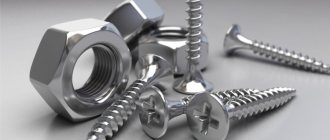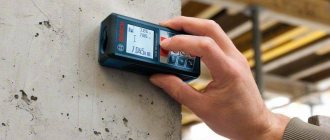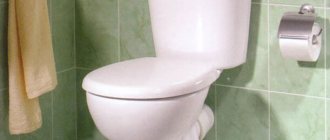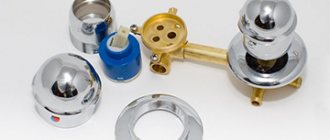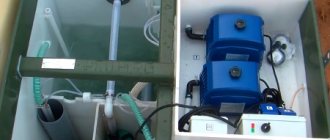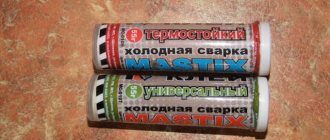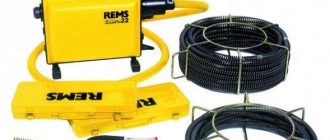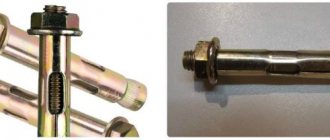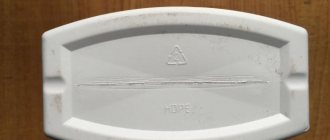Self-tapping screws for concrete are self-tapping screws for installing attachments, window or door frames, sheathing, insulation and finishing panels. When screwed in, the metal fastener forms an internal thread in the hole, thanks to which it is firmly held in the monolith.
Pockets are formed in the concrete body that work not for expansion, but for shear. This prevents the appearance of tearing forces in the material and the displacement of the fastening during operation.
Using concrete screws
Concrete screws are used in construction due to their strength, corrosion resistance and versatility. They are made of alloy or carbon steel, brass and coated with protective compounds.
Reliability of fixation is achieved by threads that are not uniform along the length of the rod. This configuration of notches allows you to secure the dowel in areas of concrete of different density.
The end of the screw has the shape of a cone. Thanks to this, it can be screwed into lightweight porous concrete without drilling. In hard and dense material, hole preparation is indispensable. Drills of various powers are used.
The length of fasteners for concrete is from 50 to 200 mm, diameter - up to 8 mm. This allows you to select hardware for a variety of purposes - from hanging a small light part to installing heavier household appliances and finishing.
When using screws, their dimensions, shape and thread pitch must correspond to the method of fastening and operating conditions. The greater the accepted weight of the equipment, the more powerful the hardware needed.
Varieties and sizes
The classification of types of self-tapping screws for concrete without drilling is carried out in accordance with:
- with material;
- coating;
- shape of the head and slot;
- thread design.
For anchor screws for concrete, GOST 1147-80 has been developed - an interstate standard for all types of such hardware.
Most often, for the manufacture of self-tapping screws, carbon steel wire of grades 08 kp, 10 kp, 10, 10 ps from a domestic manufacturer or S1010, S1018, S1022 is used. After turning the product from a blank, it is given surface strength by hardening.
For protective coating use:
- galvanization (silver or yellow color of products) - a layer of zinc is applied by galvanic method, this protects the self-tapping screw from corrosion in a humid environment;
- phosphating - a gray or black coating is formed when steel reacts with phosphates;
- oxidation (ferrous hardware) - the film on the surface is obtained by chemical interaction with oxidizing agents.
Self-tapping screws made of stainless alloy steel are used without coating. Chromium and nickel in its composition give the alloy anti-corrosion properties.
Brass screws are durable fasteners that are resistant to aggressive environments. Disadvantage: plasticity, tendency to deform.
The design of the head can be secret or protruding, in the form of a hexagon, cylinder, half-cone. The slot for self-tapping screws for concrete is usually cross-shaped, star-shaped Torx, hexagonal for a socket wrench or barrel-shaped for a socket. Direct is not used, since it does not provide the transfer of significant forces necessary to tighten the fastener into dense, heterogeneous material.
Self-tapping screws are threaded:
- Universal. Multifunctional fasteners are used with or without a dowel. Concrete screws are available in sizes up to 6 mm in diameter and up to 220 mm in length.
- In the shape of a Christmas tree. Inclined threads are formed by cones nested inside each other. The cross-section of the screw is increased to 8 mm, length - up to 200 mm. The hardware is hammered into the drilled hole or a dowel is used for fitting.
- With a variable pitch of turns. For more reliable fastening, the threads are given a variable pitch and additionally notches are made. This allows you to use hardware without an expansion dowel. Sometimes self-tapping screws for concrete without drilling are called turbo screws. Their protrusions and depressions are located throughout the rod. The outer diameter of the dowel is 7.5 mm, length - from 52 to 212 mm.
The table for the assortment of self-tapping screws for concrete shows the characteristics of the products and the weight of 1000 pieces.
General information
Although the modern construction market offers many options, self-tapping screws remain the most popular. They are screws of a rod-shaped, pointed shape, the head of which has a cross notch. Such a fastening element is characterized by high strength, which allows it not to bend or collapse under the influence of heavy loads.
How to use a concrete screw when working with foam concrete
Material
For the manufacture of self-tapping screws, various materials can be used, which are selected depending on the type and conditions of use.
The main ones are:
- carbon steel;
- stainless steel;
- brass.
The common feature of each of them is high strength, and their prices are not much different from each other.
The most common fasteners are made from carbon steel. Such self-tapping screws have an additional protective coating that protects them from oxidation and other types of influences.
Anchor screws for concrete
In order not to get confused about the types of coatings for carbon steel, you need to remember their color designation:
| Silver | In this case, the protective coating is a layer of zinc. Such self-tapping screws can be used equally effectively for various jobs. |
| Yellow | Such fasteners are also treated with zinc, but they have a slight drawback compared to silver ones. It can only be used when working with concrete indoors. |
| Black | Another type of coating for carbon steel screws is oxidized. They are recommended for use during interior work in rooms with normal air humidity levels. |
Before installing the self-tapping screw, make a hole for the dowel using a hammer drill
Kinds
Self-tapping screws can come complete with dowels or simply be screwed into the surface with your own hands without them.
Due to the various characteristics of the elements, they can be divided into three main groups, each of them characterized by different properties:
- Universal with medium thread pitch. The length range of such fasteners lies in the range of 12-220 mm, and the diameter is 3-6 mm. They can be used equally effectively with or without concrete anchors in foundations made of brick (concrete).
In the photo - a self-tapping screw with a herringbone thread
- With herringbone thread. The length range is similar to the first group, and the diameter can be in the range of 3-8 mm. These elements are secured only using dowels. To create a hole for the dowel, use a drill whose diameter is equal to the diameter of the dowel. The drilling depth should be 3-5 mm greater than the length of the latter, and the self-tapping screw should have a similar length.
Installation of self-tapping screws in concrete without drilling
- Pins are a variable type of thread with notches. Such elements have different lengths (ranging from 70-200 mm) and a constant diameter of 7.5 mm. It is used without a dowel. To install it, it is necessary to drill a hole Ø 6 mm in the base and a length exceeding the length of the self-tapping screw by 10-15 mm.
How to screw a self-tapping screw into concrete?
There are two ways to screw a screw into concrete - with or without a dowel. A plastic sleeve installed in the hole creates a reliable grip thanks to petals, hooks or spikes that work to expand when screwing in the element.
The dowel is installed in cases where additional adhesion area is needed:
- with heavy loads on the self-tapping screw;
- when fastening to porous or cellular concrete;
- in structures subject to vibration.
The sequence of installing self-tapping screws for concrete with a plastic sleeve:
- In a concrete wall, using an electric drill, a screwdriver with a drill (if the material is soft or porous) or a hammer drill (if the density is 700 kg/m³ and higher), drill a hole with a diameter equal to the cross-section of the dowel and a depth 3-5 mm longer.
- Clean the channel from drilling waste.
- Use a hammer to drive the dowel into the socket.
- Screw the self-tapping screw into the prepared seat using a screwdriver or screwdriver.
When installing self-tapping screws without drilling, two methods are used:
- with preliminary channel marking;
- according to the prepared template.
In the first case, a hole is drilled with a diameter smaller than the self-tapping screw. A screw with a herringbone thread is driven in with a hammer. It will no longer be possible to use it again.
When using a template, the self-tapping screw is screwed into the concrete directly through the hole in the template. It is made from a block or cutting a board. The fastener will be firmly fixed perpendicular to the surface.
The method of fastening a self-tapping screw without drilling is not used if the structure is made of cellular materials with large pores.
Briefly about the main thing
Conventional universal self-tapping screws, complete with a plastic dowel sleeve, allow you to firmly secure any structure to a concrete base. But even more reliable are dowels - special screws for concrete with a special thread. Its ribs easily bite into dense material, cutting spiral grooves in it. When choosing such fasteners, you need to take into account the operating conditions and the availability of a tool for installation - it must fit the slots or the shape of the screw head.
Ratings 0
Requirements for the location of self-tapping screws for concrete
Before using screws, you need to mark the fasteners:
- they retreat from the edge of the structure to a distance of at least twice the length of the anchor;
- the depth of the hole must be greater than the length of the self-tapping screw by the value of one of its diameters;
- the minimum recommended dowel insertion depth for lightweight concrete is 60 mm; for heavy ones - 40 mm;
- distance between anchors - 120 mm for porous, 150 mm - for dense materials;
- The diameter of the hole must correspond to the cross-section of the dowel.
The fasteners are positioned so as not to cause the formation of cold bridges.
Dowel selection
When purchasing various objects to attach to a concrete wall, you should choose the right dowel for concrete; its approximate dimensions can be selected from the table:
Table for determining the dimensions of a fastener depending on the type of load on it
Fasteners are selected depending on the type of place where they will be used.
Before driving a dowel into a concrete wall, the future load must be taken into account:
To secure structures of large mass, for example, wall bars or wall-mounted exercise machines, it is best to use dowels with a mounting depth of at least 85 mm; When fixing horizontally into a concrete wall, it is recommended to purchase fastening elements in which the fastening depth is at least 30 mm, and the diameter of the dowel on the outside is 7 - 11 mm; For the installation of a suspended ceiling, lamps, where the main load is located below, fasteners should be selected with spacer antennae and transverse notches; When selecting dowels for an already drilled hole, it is important that the parameters of the fastener and the diameter of the hole match each other. In this case, the dowel for expanded clay concrete or other material must have a diameter no less than the size of the hole; When using mounting fasteners, in order to prevent the destruction of weak walls, the dowel should serve as a softening pad
In this case, the fastener fits quite tightly to the fastener, and the load is distributed evenly throughout the product.
Features of installing dowels in the wall
Technology for installing dowels in a concrete wall
To do the work yourself you need to purchase:
- Electric drill;
- Pobedit drill;
- Sharp nail;
- Dowel of the desired design;
- Electrical tape;
- Small hammer.
After preparing all the tools, you can begin installing the dowels.
Work instructions:
- Mark the installation location of the fasteners with a ballpoint pen or a simple pencil;
- A small indentation is made with a nail, hacksaw or pin. This will allow you to correctly align the drill when making a hole;
- If the number of dowels was calculated incorrectly, you can make the product yourself. To do this, take wooden blocks of the required length. They are given a rounded cross-section, thickening at the top and decreasing in diameter at the bottom. After this, screw the screws into the concrete without a dowel;
- A drill of the required diameter is inserted into an electric drill;
- The drill is placed in the previously made recess. The drill is positioned strictly perpendicular to the surface;
- The resulting dust and cement chips are removed from the drilled hole. This can be done using a vacuum cleaner;
- The dowel is carefully inserted and hammered in with a hammer, but not too hard, until it stops;
- A screw is screwed into the dowel if it is included in the structure.
To correctly hammer a dowel into a wall, you should watch the video in this article.
Installing a spring dowel
Features of choice
To choose the right screw for concrete, you need to evaluate the load, working conditions, purpose and price of hardware:
- Calculate the load on the dowel. The weaker the material and the greater the weight accepted, the longer the fastener should be. Small objects up to 1 kg can be fixed with a rod with dimensions 3x16mm. Loads of up to 5 kg are supported by 3x25 mm dowels in porous bases and 3x20 mm dowels in dense bases. For fastening structures up to 20 kg, concrete screws with a diameter of 4 mm and a length of 20-70 mm are suitable. A dowel with a cross section of 5-6 mm is used to take weight up to 50 kg, 8-10 mm - up to 100 kg.
- To operate fasteners in conditions of high humidity, choose galvanized or stainless steel screws. They are resistant to corrosion and are not destroyed by water. Black oxidized or phosphated ones are used in dry rooms.
- The varied design of hardware heads allows you to select screws for any interior or hide them under decorative overlays.
- On average, the price of 3.5x16 mm products ranges from 120 to 200 rubles. for 100 pieces, 4x25 - 170 rubles, 7.5x202 mm - 1200 rubles. The cost varies greatly depending on the quality of the steel, coating option, and country of manufacture.
Self-tapping screws for concrete are used in construction and repair for the installation of parts, components, and equipment. They are used for finishing rooms, fastening hanging furniture, and interior elements. It is important to choose the right screws in accordance with the purpose, operating conditions and load-bearing capacity of the fastener.
Product selection
There are several types of self-tapping screws, which differ from each other in the type of fastening, material and structure. The choice of one name or another depends on the situation and external influences that have a direct impact on the fastener. Let's look at the most common types of self-tapping screws and their scope of application.
Self-tapping screws with dowels
Self-tapping dowel for foam concrete with a plastic casing
This is the most common type of fastener on the construction market - they are produced in the form of self-tapping screws with two types of threads and plastic dowels. The presence of a dowel is explained by the fact that a hole drilled in concrete is not able to provide a tight fixation, without which the fastening will not be reliable. The plastic casing acts as a seal, which smooths out this circumstance as much as possible.
If you are selecting self-tapping screws for aerated concrete, then fastenings with dowels are the best option. Given the low density of the foam material, self-tapping screws for aerated concrete without a sealant will not be able to provide the required reliability factor.
The plastic casing increases the contact area of the self-tapping screw with the wall, which is especially important in the case of low-density concrete.
There are two types of self-tapping screws with dowels, which differ from each other in the structure of the thread.
Herringbone carving
- “Herringbone”. The herringbone profile is a non-communicating thread that is fixed in the hole using the principle of driving nails into concrete. Once fixed, such a self-tapping screw cannot be removed by unscrewing, which significantly complicates dismantling. However, they also do not need to be tightened - a few strong blows are enough, which in some cases can significantly simplify the installation process;
- Universal profile. This product looks like an ordinary self-tapping screw and is mounted accordingly. The screw is simply screwed into the dowel, and during dismantling it is removed by unscrewing. This type of fastening is somewhat inferior in reliability to the previous name.
Dowel fastening diagram
The dimensions of self-tapping screws for concrete range from 3 to 6 mm in diameter and from 12 to 220 mm in length of the product. Herringbone screws can be larger in diameter, but are somewhat limited in length.
Installation of self-tapping screws with dowels is carried out in pre-drilled holes, which must correspond to the diameter of the plastic casing. The dowel should fit tightly into the hole and not dangle. After which the fastening element itself is driven into it.
Self-tapping screws without dowel
Screws without dowel
Before screwing a self-tapping screw into concrete without a dowel, you need to drill a hole with a special drill with a diameter of 6 mm (the diameter of the dowels is 7.5 mm). Only after this is the screw screwed into the hole using a screwdriver - the variable notch will expand the cavity, and the upper thread will secure the self-tapping screw.
Variable thread screw
This type of fastening refers to stationary solutions - before screwing a self-tapping screw into concrete, you need to accurately determine its location, since after fixing, it will no longer be possible to unscrew the fastener.
Coverage type
For the most part, self-tapping screws for concrete are made of carbon steel, which is coated with a protective layer to protect against corrosion. The exception is stainless steel screws, but their price is an order of magnitude higher than their conventional counterparts.
There are several options for protective coating, among which the following should be highlighted:
Galvanized. The zinc layer has a characteristic metallic silver luster - this is the most reliable anti-corrosion coating today. This product can be used both indoors and outdoors;
Zinc and oxide coating
- Copper-plated. Yellow screws are copper or brass plated - their use is limited to interior work;
- Oxidized. Black self-tapping screws are blackened, as a result of which an oxide film is formed on their surface, which prevents the formation of rust. They can only be used in conditions with normal humidity.
